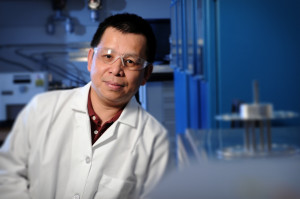A team of researchers from West Virginia University has had its groundbreaking research on converting solar energy to fuel published in Nature Photonics, a prestigious peer-reviewed scientific journal.

The team, led by Nianqiang Wu, professor of mechanical and aerospace engineering, has developed a new mechanism to be used in solar energy conversion: plasmon-induced resonance energy transfer.
“Solar-to-fuel conversion is similar to a solar panel, but instead of directly creating electricity, sunlight is used to create a renewable fuel for later use,” said Wu. “Unlike turning sunlight into electricity, however, not all of the solar spectrum can be utilized because of the energy needed to create fuels such as hydrogen.”
Metals like silver, gold, copper and aluminum are known for their distinctive color. But when you shrink them down, the color is adjusted.
“Nanostructured silver, gold, copper and aluminum are powerful optical antennas, absorbing light as if they were many times their physical size,” said Wu. “The research group is using these properties to engineer better sunlight absorption.”
The trick, according to Alan Bristow, assistant professor of physics in the Eberly College of Arts and Science at WVU, comes in getting the energy from the metal to the rest of the solar cell.
“According to Heisenberg’s famous uncertainty principle, we can know the exact position or speed of an electron, but not both at the same time,” said Bristow. “A similar uncertainty between energy and time becomes very important at the nanoscale.”
After light is absorbed by the metal nanoparticle, Bristow said, there is an exceedingly short time in which to extract the energy before it is wasted as heat. The short lifetime leads to uncertainty in the energy, which can be readily exploited.
The research team, whose work has been funded by grants from the National Science Foundation and the U.S. Army Research Laboratory, has engineered a structure that takes the energy from the nanoparticle very quickly, thus taking advantage of this uncertainty while remaining true to energy conversion laws.
While commercial implementation is still years away, Wu is encouraged by the team’s progress.
“President Barak Obama’s Clean Power Plan, which was recently announced, proposes 30 percent more renewable energy generation by 2030. I think it’s fair to say we are hot on the trail of making that attainable through this technology,” he said.
Joining Wu and Bristow on the research team are postdoctoral fellow Jiangtian Li and graduate students Scott Cushing, Fanke Meng and Tess Senty.